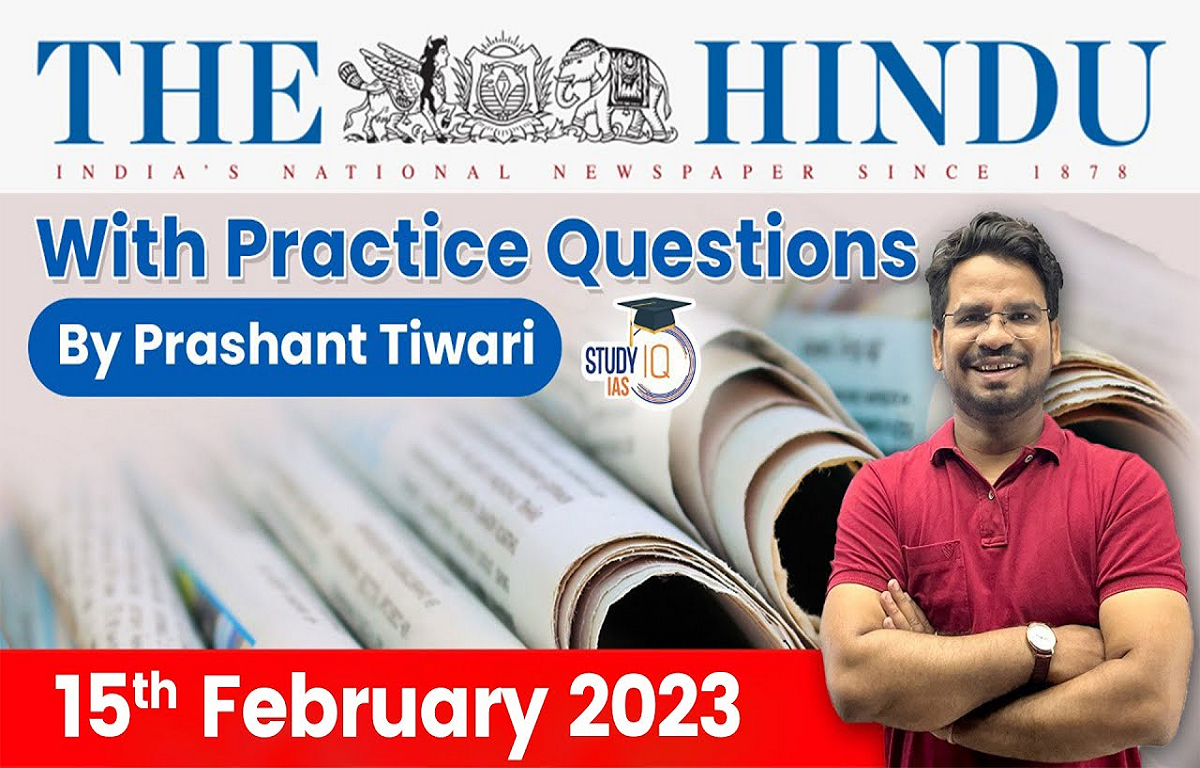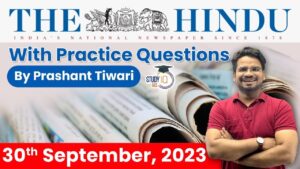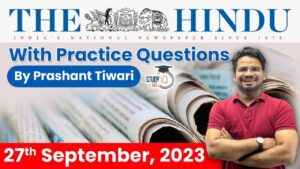The Hindu Newspaper Analysis for UPSC

The Hindu Newspaper Analysis 14 February 2023

The Hindu Editorial Today
- Just five days after Reserve Bank of India Governor Shaktikanta Das asserted that inflation ‘has shown signs of moderation and the worst is behind us’, Monday’s release of Consumer Price Index (CPI) estimates for January revealed a disconcerting reversal in price gains trend. Headline retail inflation, which had steadily eased over the last quarter of 2022 from September’s five-month high of 7.4%, quickened by 80 basis points last month to 6.5%.
- The surprise reversal in price trends suggests inflationary expectations in the economy are nowhere near anchored and will necessitate further policy action both from the RBI and fiscal authorities.
- Given that inflation in several key services categories including health and personal care is running well above the RBI’s upper bound of 6%, with prices continuing to harden, the Centre and States must mull measures including rationalisation of GST rates to help ease the inflationary burden on the economy. With overseas demand set to stay weak this year, untamed inflation risks hurting domestic consumption and thereby overall economic growth.
- What is the Consumer Price Index (CPI)?
- The Consumer Price Index is the name given in India to the index that shows the rate of inflation at the retail level (CPI).
- The CPI basket comprises 448 items in rural and 460 items in urban.
- There were four Consumer Price Indices in the economy, each covering a different socioeconomic group. Consumer Price Index for Industrial Workers (CPI-IW), Consumer Price Index for Agricultural Laborers (CPI-AL), Consumer Price Index for Rural Laborers (CPI-RL), and Consumer Price Index for Urban Non-Manual Employees (CPI-UNME) were the four indices.
- CPI is now using a new series based on the base year 2012 for all of India as well as States/UTs separately for rural, urban, and combined.
- Consumer Price Indices are published by the National Statistics Office (NSO), Ministry of Statistics and Program Implementation (MOSPI).
- What is the Wholesale Price Index (WPI)?
- In India, this is the most widely used method for calculating the inflation rate. The Wholesale Price Index is the index used to calculate wholesale inflation (WPI).
- This rate of inflation is commonly referred to as headline inflation. The Office of Economic Advisor, Ministry of Commerce and Industry publishes the WPI. The base year is aligned with CPI as 2012=100.
- Prior to 2014, the RBI used WPI to make the majority of its policy decisions. However, the WPI-based inflation calculation was not false proof. WPI displays the total price of a commodity basket of 697 items.
- The RBI shifted to CPI for policy decisions beginning in 2014.



- The estimation in Census 2011, that 2.21% of India’s population is disabled is a gross underestimation. According to the World Health Organization, about 16% of the global population is disabled.
- While technology has enormous potential to level the playing field for the disabled, it can, at the same time, reinforce the barriers that the disabled otherwise face if it is not designed with their needs in mind.
- Being blind ourselves, we know that there is a long way to go when it comes to making apps disabled friendly.
- Core to the project of securing a more disabled friendly digital ecosystem must be the conviction that, “everything digital must be accessible to everyone”


- Since 2019, the celebratory mood has considerably diminished. Many Ladakhis have realised that their real need of relatively free and autonomous functioning and substantial local employment generation is still a mirage. For 1,000 years, Ladakh was an independent kingdom before being integrated into Jammu and Kashmir (J&K).
- The memory of this long history has not been erased, and it rankles that while it is no longer subject to J&K, Ladakh is now being ruled from New Delhi.
- Sixth Schedule status was promised to the region, similar to what is seen in some parts of north-east India.
- It is important to understand the sensitivity of Ladakh. The region’s cold desert ecosystems harbour rare mammals like the wild yak and the snow leopard, and diverse flora. Cultures and livelihoods have evolved to be sensitive to the fragility of ecosystems that cannot bear heavy human activity. High-altitude pastoralism, agriculture, and trade have been the mainstays of Ladakhi economy and society for centuries.
- Administrators sitting in or appointed from Delhi hardly comprehend what can and cannot work in such a landscape. Ladakh is already groaning under infrastructure development, intense armed forces presence, and excessive tourism.
- Since Ladakh became a UT, there is even more focus on an exploitative ‘development’ path. There is enormous commercial interest for mining, tourism, hydropower, and other natural resources.
Sixth Schedule
- The sixth schedule under Article 244 of the Constitution protects the autonomy of tribal populations through the creation of autonomous development councils which can frame laws on land, public health and agriculture. As of now, ten autonomous councils exist in Assam, Meghalaya, Tripura and Mizoram.
NCST Recommendation:
- The National Commission for Scheduled Tribes (NCST) has recommended that the Union Territory (UT) of Ladakh be included in the Sixth Schedule of the Constitution.
The provisions in the Fifth Schedule and Sixth Schedule in the Constitution of India are made in order to (UPSC 2015)
- (a) protect the interests of Scheduled Tribes
- (b) determine the boundaries between States
- (c) determine the powers, authority and responsibilities of Panchayats
- (d) protect the interests of all the border States

- For decades now, better-educated women have had more control over when they should get married
- root of the problem — limited access to education among women — is still not being addressed.
- Data from NFHS-5 show that the more educated a woman, the higher her negotiating power about when she wants to get married. Interestingly, this is not a recent phenomenon. Data suggest that for decades now, better-educated women have had more of a say on when they should get married.
- Though wealth has recently gained relevance, education continues to be the dominant controlling factor of the two. The median marriage age of women from the wealthiest households was still lower than that of women who completed over 11 years of schooling (E-K). Also, the median marriage age of women from the poorest households was still higher than that of women who have had no schooling (A-F).

- The anti-defection law punishes individual Members of Parliament (MPs)/MLAs for leaving one party for another.
- Parliament added it to the Constitution as the Tenth Schedule in 1985. Its purpose was to bring stability to governments by discouraging legislators from changing parties.
- The Tenth Schedule – popularly known as the Anti-Defection Act – was included in the Constitution via the 52nd Amendment Act, 1985.
- However, it allows a group of MP/MLAs to join (i.e., merge with) another political party without inviting the penalty for defection. And it does not penalize political parties for encouraging or accepting defecting legislators.
- As per the 1985 Act, a ‘defection’ by one-third of the elected members of a political party was considered a ‘merger’.
- But the 91st Constitutional Amendment Act, 2003, changed this and now at least two-thirds of the members of a party must be in Favour of a “merger” for it to have validity in the eyes of the law.
- The members disqualified under the law can stand for elections from any political party for a seat in the same House.
- The decision on questions as to disqualification on ground of defection are referred to the Chairman or the Speaker of such House, which is subject to ‘Judicial review’.
- However, the law does not provide a timeframe within which the presiding officer has to decide a defection case.
What are the Grounds of Disqualification?
- If an elected member voluntarily gives up his membership of a political party.
- If he votes or abstains from voting in such House contrary to any direction issued by his political party or anyone authorized to do so, without obtaining prior permission.
- If any independently elected member joins any political party.
- If any nominated member joins any political party after the expiry of six months.



- Chinese President Xi Jinping on Tuesday pledged “unswerving” support to visiting Iranian President Ebrahim Raisi in talks in Beijing, with both countries vowing to step up trade ties despite the threat of American sanctions.
- “China has always viewed and developed its relations with Iran from a strategic perspective,” State media quoted Mr. Xi as saying in Tuesday’s talks. “No matter how the international and regional situation changes, China will unswervingly develop friendly cooperation with Iran, push for new development of the China-Iran comprehensive strategic partnership, and play a positive role in world peace and human progress.”
Joint Comprehensive Plan of Action (JCPOA)
- The deal is also known as 2015 Iran Nuclear Deal.
- The JCPOA was the result of prolonged negotiations from 2013 and 2015 between Iran and P5+1 (China, France, Russia, the United Kingdom, the United States + Germany).
- Under the deal, Iran agreed to significantly cut its stores of centrifuges, enriched uranium and heavy-water, all key components for nuclear weapons.
- Iran also agreed to implement a protocol that would allow inspectors from the International Atomic Energy Agency (IAEA) to access its nuclear sites to ensure Iran would not be able to develop nuclear weapons in secret.
- After US abandoned the deal in 2018 and reinstated banking and oil sanctions, Iran ramped up its nuclear programme in earnest, returning to approximately 97% of its pre-2015 nuclear capabilities.

- The discovery of the 5.9 million tonnes inferred resources of lithium in Reasi in Jammu & Kashmir has been heralded as a game-changer in India’s transition to a green economy. India’s market for critical metals is projected to register a compounded annual growth rate of 23.76% by 2028.
- This will also help advance the Indian government’s ambitious plan of “30% EV penetration in private cars, 70% for commercial vehicles, and 80% for two and three-wheelers by 2030 for the automobile industry.”
- The applications of lithium in renewable energy infrastructure often obscures its significant environmental consequences. Extracting lithium from hard rock mines, similar to what has already been proposed in J&K, entails open-pit-mining followed by roasting the ore using fossil fuels. Industry estimates suggest that this process consumes 170 cubic metres of water and releases 15 tonnes of CO2 for every tonne of lithium extracted.
- As India embarks on this new journey, it could learn from the experiences of South American countries, especially the ‘lithium triangle’ of Bolivia, Chile, and Argentina.
- The term ‘inferred’ refers to the ‘preliminary exploration stage’, the second of a four-step process, according to the Mines and Minerals (Development and Exploration) Act 1957.
- In recognition of the local effects of mining, in 2015, the Lok Sabha amended the Mines and Minerals (Development and Regulation) Act 1957 to establish the ‘District Mineral Foundation’ (DMF). The DMF is a non-profit statutory ‘trust’ for every Indian district affected by mining-related operations that should “work for the interest and benefit of persons, and areas affected by mining-related operations”.
- As India currently imports all of its Li from Australia and Argentina and 70% of its Li-ion cell requirement from China and Hong Kong, the lithium reserves in J&K could boost the domestic battery-manufacturing industry.
- Chile > Australia > Argentina are top countries with Li reserves.
- Lithium Triangle: Chile, Argentina, Bolivia.
Q) Black Hole Tragedy is associated with
- The Carnatic wars
- The Anglo Maratha wars
- The Battle of Buxar
- The Battle of Plassey
ब्लैक होल त्रासदी संबंधित है
- कर्नाटक युद्ध
- आंग्ल मराठा युद्ध
- बक्सर की लड़ाई
- प्लासी की लड़ाई
Explanation:
- One of Kolkata’s historical monuments, Fort William was built during the time of the Bengal Presidency.
- Named after William III, the fort sits on the banks of the Hooghly River and was at the centre of the Battle of Plassey fought between the British and the Nawab of Bengal, Siraj-ud-Daulah.
- It is also the site of an infamous dungeon called the Black Hole of Calcutta (the city of Kolkata was erstwhile known as Calcutta).
Q) Global Quality Infrastructure Index is an initiative of
- WEF
- ITU
- IMF
- none of the above
ग्लोबल क्वालिटी इंफ्रास्ट्रक्चर इंडेक्स की एक पहल है
- डब्ल्यूईएफ
- आईटीयू
- आईएमएफ
- उपर्युक्त में से कोई नहीं
Explanation:
- India’s national accreditation system under the Quality Council of India (QCI) has been ranked 5th in the world in the recent Global Quality Infrastructure Index (GQII) 2021.
- The GQII ranks 184 economies on the basis of their quality infrastructure (QI)
- GQII is an initiative on metrology, standardization, accreditation, and related services, supported by Physikalisch-Technische Bundesanstalt (PTB) and the Federal Ministry for Economic Cooperation and Development (BMZ), Germany
- India’s overall QI system ranking continues to be in the Top 10 at the 10th position, with the standardization system (under BIS) at 9th and the metrology system (under NPL-CSIR) at the 21st position in the world
Q) TARKASH is a joint military exercise between India and
- USA
- Sri lanka
- Japan
- Russia
तारकश भारत और के बीच एक संयुक्त सैन्य अभ्यास है
- यूएसए
- श्रीलंका
- जापान
- रूस
Explanation:
- Context: It is an ongoing Indo-US joint exercise (TARKASH) by the National Security Guard (NSG) and US Special Operations Forces (SOF) has for the first time included “Chemical, Biological, Radiological, and Nuclear (CBRN) terror response” in its drill
Q) A Democratic constitution would lose its credibility if
- It is heavily based on the Constitution of another nation.
- It is not based on secular ideas.
- The people behind framing the Constitution were unelected.
- It centralizes power from the federal units into the Union government.
एक लोकतांत्रिक संविधान अपनी विश्वसनीयता खो देगा अगर
- यह दूसरे राष्ट्र के संविधान पर बहुत अधिक आधारित है।
- यह धर्मनिरपेक्ष विचारों पर आधारित नहीं है।
- संविधान बनाने वाले लोग अनिर्वाचित थे।
- यह संघीय इकाइयों से केंद्र सरकार में शक्ति को केंद्रीकृत करता है।
- The Indian constitution borrows heavily from the constitution of other nations.
- Suppose if the constituent assembly of India consisted of British administrators and only members of princely states, we wouldn’t have acknowledged the framing of the constitution as just and democratic.
Q) Consider the following statements regarding Rajya Sabha elections.
- The Third Schedule to the Constitution provides for allocation of Rajya Sabha seats to the states and Union Territories, on the basis of the population of each state.
- Rajya Sabha MPs are elected by the elected members of state Assemblies through a system of proportional representation by means of a single transferable vote.
Which of the above statements is/are correct?
- 1 only
- 2 only
- Both 1 and 2
- Neither 1 nor 2
राज्यसभा चुनाव के संबंध में निम्नलिखित कथनों पर विचार करें।
- संविधान की तीसरी अनुसूची प्रत्येक राज्य की जनसंख्या के आधार पर राज्यों और केंद्र शासित प्रदेशों को राज्यसभा सीटों के आवंटन का प्रावधान करती है।
- राज्य सभा सांसदों का चुनाव राज्य विधानसभाओं के निर्वाचित सदस्यों द्वारा एकल संक्रमणीय वोट के माध्यम से आनुपातिक प्रतिनिधित्व प्रणाली के माध्यम से किया जाता है।
उपरोक्त कथनों में से कौन-सा/से सही है/हैं?
- केवल 1
- केवल 2
- 1 और 2 दोनों
- न तो 1 और न ही 2
- The Fourth Schedule to the Constitution provides for allocation of Rajya Sabha seats to the states and Union Territories, on the basis of the population of each state.
- Rajya Sabha MPs are elected by MLAs through an indirect election. Article 80(4) provides that members shall be elected by the elected members of state Assemblies through a system of proportional representation by means of a single transferable vote.


 The Hindu Newspaper Analysis 6 October 2...
The Hindu Newspaper Analysis 6 October 2...
 The Hindu Newspaper Analysis 30 Septembe...
The Hindu Newspaper Analysis 30 Septembe...
 The Hindu Newspaper Analysis 27 Septembe...
The Hindu Newspaper Analysis 27 Septembe...





















